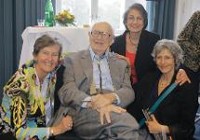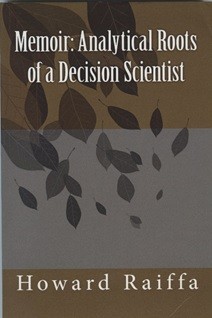05 August 2016
In Memory of Howard Raiffa
Howard Raiffa – In Memoriam
By Detlof von Winterfeldt
Howard Raiffa holds a special place among my intellectual heroes. He is best known as a founding father of decision analysis, but he also laid the foundation of risk analysis, game theory, and negotiation analysis. Early in his career, in 1957, he published “Games and Decisions” (with R. Duncan Luce), which explained and extended the ideas of von Neumann and Morgenstern’s classic “Theory of Games and Economic Behavior” to a wider audience. Tom Schelling, another great IIASA alumnus, said many times that he learned game theory from this book, as did many others who went on to win Nobel prizes in economics. More path-breaking books followed including “Applied Statistical Decision Theory” (with Robert Schlaifer) in 1961, “Decision Analysis” in 1968, “Decisions with Multiple Objectives” (with Ralph Keeney) in 1976, and “The Art and Science of Negotiation” in 1982. These books had a tremendous influence on all of us in a field that can broadly be described as decision science (a term that Howard preferred.)
In addition to providing us with a huge intellectual heritage, he also gave us IIASA. He was part of the negotiation team that created IIASA and later led the Institute as its founding director from 1972 to 1975. I came to IIASA as a research scholar in 1975, at the end of his term as director. By then I had read all of his books, including a draft of “Decisions with Multiple Objectives.” His co-author, Ralph Keeney, also was a IIASA research scholar at the time and he asked me to review the book. I read it cover-to cover and provided some comments, which cemented my adoration for Howard and led to a life-long friendship with Ralph. I continued to communicate with Howard over the years and later followed in his footsteps as the 11th director of IIASA (see picture below in the Elisabeth Room in 2012).
When I became Director of IIASA, the spirit of Howard was evident everywhere. Of course, there were some obvious signs of his legacy, like the Raiffa Room, a favorite meeting place in the Schloss. But there also were subtler signs. His office (which I later occupied) was not one of the decorated historical rooms which reflected the pomp and circumstance of the Habsburg dynasty. Instead it was one of the modest, utilitarian rooms designed for a working scholar. A visitor once stepped into my office and said “You are clearly making a statement that you are one of the workers in the Institute.” I did not mean to, but Howard clearly did, and I simply followed his lead.

(L-R) Arne B. Jernelöv (Acting Director, 2000-2002), Sten Nilsson (Acting Director, 2008-2009), IIASA Director General and CEO Professor Dr. Pavel Kabat, Leen Hordijk (Director, 2002-2008), Howard Raiffa (Director, 1972-1975), Roger Levien (Director, 1975-1981), C.S. Holling (Director, 1981-1984), Detlof von Winterfeldt (Director, 2009-2012)
In the last year of his life, Ralph Keeney and I helped organize a session in honor of Howard Raiffa for the conference “Systems Analysis 2015” (see the picture below which shows the three of us working together in preparation for this conference at Howard’s Arizona home). Howard thoroughly appreciated the research conducted at IIASA over the years, but he had one wish: That IIASA researchers would work more closely and more directly with high-level decision makers to understand and address their concerns and help them achieve important social objectives. He expressed this wish in his opening comments to the conference.

Detlof von Winderfeldt with Howard Raiffa and Ralph Keeney
Everyone who read his work, admired Howard as a great scholar and intellectual leader. The IIASA community is indebted to him for creating a very important place for joint East-West research and collaboration which evolved into a first class global research institution. Those of us who knew him personally, loved his humility and humanity. We will miss him tremendously.
"Howard in the Hallway" by Roger E. Levien, IIASA Director 1975-1981
At Harvard, Prof. Howard Raiffa’s most consequential venue was the lecture room, where in scheduled classes his sharp intellect and rich experience inspired future executives from around the world to adopt decision analysis. At IIASA, his most influential venue became the hallway, where in chance meetings his ambitious vision and contagious enthusiasm inspired each one of his quickly gathered multinational and multidisciplinary medley of researchers to pursue the Institute’s founders’ impossible dream: erecting a reliable bridge of analysis across an international chasm of mistrust.
To understand the challenge Howard Raiffa faced, remember that at that time, the early 70s, Richard Nixon occupied the White House, Leonid Brezhnev ruled from the Kremlin, and the Cold War cooled most East-West relations. Moreover, there was no precedent for a neutral international policy research institute, let alone one sponsored and supported by nations on both sides of the East-West divide. Nor for that matter, were there many successful applied inter-disciplinary research institutes beyond the few in the United States. It was Howard’s task to meld his highly differentiated raw material into a coherent international and interdisciplinary policy research program in the absence of an established model –and he had two years to build it!
If Howard had adopted the then common European academic style, he might have ruled the Institute by dictat from his office, occupying his honored position of Professor Doctor Director Raiffa. But I am certain that never entered his mind. Howard minimized hierarchy and formality, encouraging everyone from support staff to distinguished scientists to call him “Howard,” That did not come naturally to most members of the staff or visitors, but they learned. And rather than remaining in his office, Howard moved about, spreading a distinctive research culture by contagious example.
On his journeys through the still-being-renovated Schloss and the temporary Administration Building, he usually engaged with those he encountered, offering his enthusiastic greeting and infectious smile to each one. Often he paused to talk, asking questions about each person’s family and work, and providing words of support and encouragement. What he accomplished in office and meeting room was certainly critical, but what was invaluable was the implicit message he conveyed during his sorties throughout the Institute. By demonstrating his wish to talk with and listen to everyone and by his minimization of hierarchy, he created an open culture in which staff from different blocs, nations, and disciplines could meld into a seamless and powerful whole – IIASA. And by continually showing his conviction of the Institute’s necessity and belief in its success, he transferred to all of IIASA’s staff the energy and commitment to proceed with confidence. The Institute’s open, informal culture and its confident commitment to accomplish challenging goals are Howard’s lasting legacy.
The Institute that Howard passed to me when he returned to Harvard was still a youngster, but one that had accomplished far more and matured far faster than any reasonable person might have expected. It was my privilege to have the responsibility to take the Institute that he had brought to life and work to continue its maturation into a successful international and interdisciplinary policy research institute and then to pass it along to its next director. Now after more than forty years of experience, we can see that the foundation that Howard established was a sturdy and resilient one, enabling the Institute to flourish despite challenges, and still showing the strong influence of Howard’s open personality and intense intellect.
Perhaps, in memory of Howard’s inspirational strolls, IIASA might name a Schloss hallway, the Raiffagang.
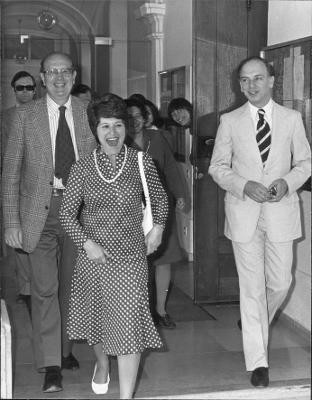
Howard Raiffa with his wife Estelle and Roger Levien
Tibor Vasko, one of the signatories on the Charter that created IIASA, served 9 years on the IIASA Council and former Dean & Scientific Coordinator of IIASA’s YSSP
I was shocked and saddened by the news of Howard’s passing. For me personally, he will forever have a special place in my memory. In my mind, he represents a fixed star in a universe that helped create IIASA. The idea of international scientific co-operative venture was met all around with enthusiasm by people of good will. To turn this idea into a real Institute needed the help of many. One outstanding person among them was Howard. It was not only the question of selecting an Institute site, management, financial arrangement, etc. under an intricate international situation, but a successful Institute is a living organism fulfilling its mission only with a well prepared and motivated staff.
I was fortunate to witness how Howard brilliantly fulfilled this. Howard was a born optimist, with infinite gentleness, devoted wholeheartedly to this duty. In a way, the Institute is a living monument to his energy and creativity.
We now mourn a friend of singular devotion to the cause of the Institute and to whom we owe so much. On my part, I will do everything to keep the light of the fixed star - Howard Raiffa – shining.
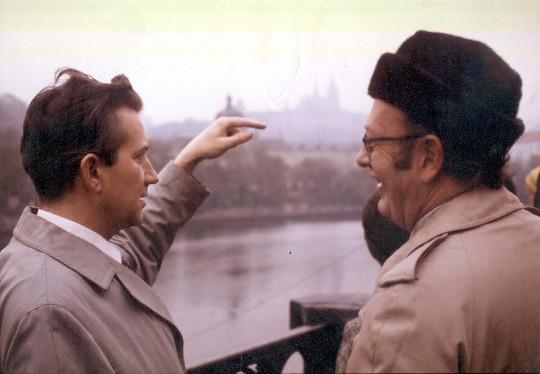
Tibor with Howard standing on the bank of Moldau River in Prague in 1973/1974
Martha Wohlwendt, 1973-1984 Executive Secretary/Administrative Assistant in the Director’s office, IIASA’s first employee
For all of us, especially those who were with IIASA in its initial years, it is impossible to think of IIASA without thinking of the wonderful, good natured person who was its first Director. Howard Raiffa made of IIASA a home away from home for many of its staff; he and Estelle were the heads of a lovely IIASA family. I always remember his warmth, his fairness, his humility. It was not only a great honor and pleasure to have worked with him – it was also so easy and rewarding! He had good judgment about people and one could always be sure that he would make the right decision.
One occasion that I will never forget, on his last day as Director, he left a Latin America party/exhibition I had organized at the entrance of the Schloss, and went back to his office. I followed to see if I could help with anything and found him in his office, signing his name behind the curtain underneath the window sill. He said to me, I’m leaving my signature here, although I know it will not be forever! We laughed at the time, but I know that he did leave his signature at IIASA!
He will be sorely missed and dearly remembered! My thoughts are with dear Estelle, Judy and Mark.
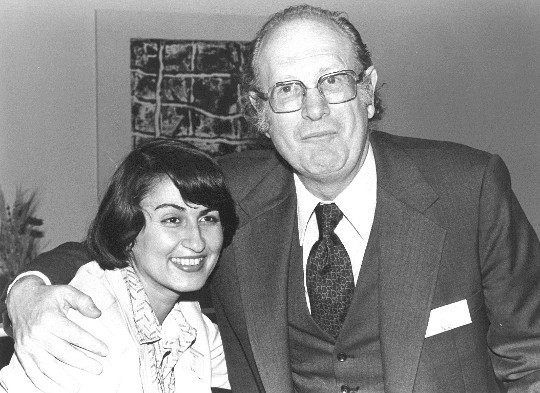
Martha Wohlwendt and Howard Raiffa
Ruth Steiner, 1973-1983 Head of the Personnel Department
In the beginning of 1973, I was hired by Howard Raiffa as Personnel Officer of IIASA. I realized what a wonderful human being he was. My employment number was 006, with Andrei Bykov 007. By the end of the 70ies, we hired 350 staff members. Howard’s personnel policy was: hire a person who had no experience but was willing to try, fire the person who said my experience tells me it will not work. My first job at IIASA was to fire my supervisor. Howard and I had a wonderful working relationship. The friendship with Estelle and Howard played a great role in my life - I will miss him.
"Remarks about Howard Raiffa" by Ralph Keeney, 1974-1976 IIASA Methodology Program
Howard Raiffa was a one-of-a-kind thinker and the best man I have ever known. He had a brilliant mind and enormous personal charisma.
Howard’s intellectual and academic achievements are widely recognized. He had a profound influence on all aspects of the decision sciences and on the fields of systems analysis and operations research. His remarkable books on game theory, Bayesian decision theory, decision analysis, decisions with multiple objectives, and on negotiation analysis were each seminal books that influenced countless individuals. He guided the introduction of the decision sciences into numerous fields such as business, medicine, public health, the environmental sciences, and law. Howard had approximately 100 doctoral students and helped thousands of students through his dedicated teaching and guidance. In addition, Howard was instrumental in founding and building world-recognized institutions such as the Kennedy School at Harvard and, as we all know, he had a key role in creating IIASA and served as its first Director.
The original vision for IIASA was of great interest and importance to Howard. He firmly believed that scientists from around the world working together to try to solve some of the world’s problems was as important as the results that may be produced by such collaboration. He held this vision and commitment for IIASA throughout his lifetime. He often spoke of the opportunities to use insights from analysis to identify and facilitate implementation of practical solutions to important world problems.
Even with his remarkable academic accomplishments, Howard's greatest interest was to improve the world for individuals, groups, and mankind. He was always focused on improving the world that we live in and our lives. He recognized that helping individuals and organizations make better decisions and groups make better negotiated choices would make a positive difference. His ideas and work provided practical methods and procedures to indicate how better choices could be made. His kindness, generosity, and warmth inspired others to do their best and take a broad perspective, including a consideration of the impacts on others in decisions and negotiations.
Before IIASA’s existence, I had the privilege to work with Howard to prepare some material relevant to non-sensitive issues about the establishment of the IIASA. My first visit with Howard in Vienna was in January 1973, three months after the creation of IIASA. Howard drove me out to the schloss and it really looked like the photos before restoration now hanging on the ground floor of IIASA. Subsequently I had a wonderful two-year period as a research scholar from 1974-76. At the Raiffa’s departure party in 1975, to recognize their enthusiastic adaption to life in Vienna, I presented Howard and Estelle with what may have been the first ever semm, which was of course an extra-large version of the regular-sized Viennese semmel.
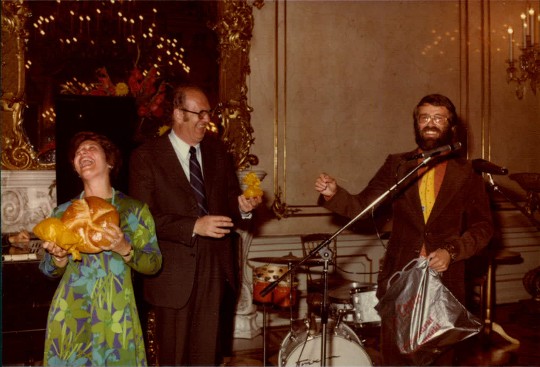
Presenting a semm to Howard and Estelle in 1975
Personally, my life has been profoundly and positively influenced by knowing Howard. Over fifty years he has held many roles in my life, including teacher, mentor, colleague, co-author, and close friend. For the last twenty-five years, my family became Howard and Estelle Raiffa's honorary family members. Howard is the godfather of our son. Howard wrote parts of his book "The Art and Science of Negotiation" on the front porch of my wife’s family cabin on a New Hampshire lake when they vacationed there.
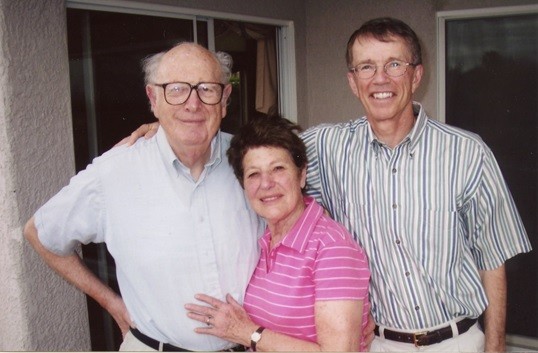
with Howard and Estelle at their Tucson Home in 2007
Howard always defined himself first as a decision scientist, the term he uses to describe himself in his memoir titled “Memoir: Analytical Roots of a Decision Scientist”. He has also held a steadfast interest in doing anything to facilitate or improve IIASA’s ability to identify and implement good solutions to global problems. It has always been a concern and hope of Howard's that the decision sciences not become primarily a theoretical discipline, but continue to be used to analyze and contribute to the better resolution of real and complex problems in the world. At the 2015 IIASA Conference dedicated to Howard, he stated the following in his opening videotaped remarks. “Looking back on what has been accomplished in systems analysis over the past decades, it seems to me that there has been less progress than desirable with integrating methodology with real decision problems. I wish I were 20 years younger so I could be with you to work on this important task”. Howard firmly believed that applying the decision sciences in IIASA projects to provide insights to policymakers about the relative desirability of various alternatives to address specific problems would be a very effective way to enhance the impact of IIASA scientific analyses.
At a large celebration of Howard's retirement from Harvard in 1994, I had the privilege to offer a few remarks about his career and contributions. Then, I concluded with "Howard, you did not leave room to exaggerate so I will grossly understate. You are simply the best". Anyone who knew Howard well would certainly agree.
Judith Raiffa, Howard's daughter
On behalf of my family, I thank you and all those who so lovingly remember my father and are helping to honor and celebrate his life and contribution to IIASA.
My mother and father loved their time at IIASA, treasuring all the people they knew there and all the experiences they had in Laxenburg. My mother holds these memories particularly dear now, and the words and photos shared in this newsletter are a marvelous reminder and comfort.
Playing his part in the creation of IIASA was, in some ways, the work my father valued most and experienced as most meaningful in his entire life. During his final years, IIASA was very much on my father's mind. He spoke of IIASA often and expressed his hope that scholars at IIASA would use decision analysis to help inform important policy decisions and make a real difference in a troubled world. He was, indeed "a born optimist with infinite gentleness", as Tibor Vasko wrote. But towards the end of his life, there was a new sense of urgency when he spoke about IIASA, perhaps because he knew there was so much potential in IIASA to play a significant role in accomplishing things he knew must be done.


